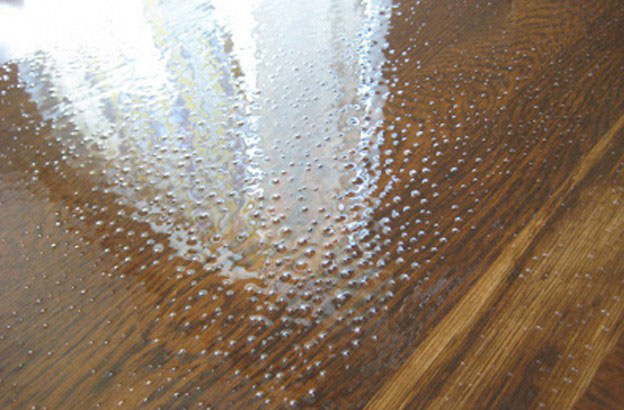
Too much bubbly can leave you with a headache. Bubbles are imperfections from foam in dry finish and can easily be confused with particles, bumps, or dirt. If you are not sure what you are dealing with, you can use a magnifying glass and a razor blade to distinguish between the two. Unlike particles or dirt, bubbles are hollow. If you are able to poke a hole with the razor blade, you are dealing with a bubble. If there is no hollow base to the imperfection, then you are dealing with another issue that is most likely related to dirt or particles that dried in the finish.
See how to prevent floor bubbles and how to repair your floor finish.
How to Prevent Floor Bubbles:
Too much working back and forth of an applicator creates bubbles. Generally this form of bubble is seen at row ends and in hard to reach areas. Flow the finish with the applicator; do not pull any more than absolutely necessary to cover the floor. Use easy strokes. Pick up the applicator like a drum sander; have it moving at the end of each stroke as you lift the applicator to feather out the stop. Have it moving as you set it down gently at the beginning of each stroke. Drop it hard and you will form bubbles and a heavy line of finish.
Very fast dry conditions can “freeze” bubbles into place before they break and the finish has a chance to flow out into a smooth film. Bubbles will be in high-air-movement areas, such as under fans, in front of doors, or by windows left open for ventilation. Close up the jobsite to apply finish. Keep the environment free of air flow for 30–45 minutes, so the bubbles have a chance to break before opening up the jobsite to dry the finish.
Hot finish on a cold floor will leave millions of very tiny bubbles on the floor. Finish left in the back of a van in the summer heat will get as hot as 160°F. This hot finish will set a quick surface film. The nature of the hot finish heats up the floor, expanding the air in the pores of the wood. As this hot air expands, it will blow a tiny bubble at the end of the wood pore under the partially set film surface. This phenomenon can be differentiated from other problems because the bubbles follow the grain pattern of the wood. Bring all materials into the jobsite so they can acclimate to the conditions on the floor. It is not as important to have them either warm or cool as it is to have them the same temperature as the floor. The finish and the floor should be the same temperature for the best results.
Another cause of bubbles is using aged, separated, or mixed finishes. Fresh and recently mixed finishes will dry smoother and level better with fewer bubbles. Rock all containers of finish before using to mix the matting agent uniformly throughout the finish. Traditionally, matte finishes need to be agitated before use, but it is a good practice to mix all finishes before use. Even single-component gloss finishes will benefit from agitation before use.
How to Repair Floor Bubbles:
If there are only a few bubbles in scattered locations, use a sharp scraper to cut off the tops of the bubbles and touch in fresh finish. If you have bubbles everywhere, but they are surface bubbles, a good screening and recoat should take care of the problem. If you scrape the tops of the bubbles, then hand sand the scraped areas with screen or strips for small spot repairs. If the bubbles are deep below the surface, then it is probably faster and more productive to just sand off the finish and start over.
If you are still having trouble with floor finish bubbles, a Basic Coatings® representative will be able to help you with your problem. Contact us today!